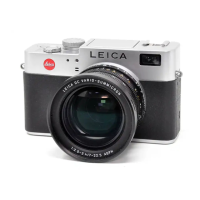130 / Detailed guide/ The most important settings/controls
Setting the ISO speed -
s
SENSITIVITY
In traditional photography, the ISO value is selected to
take account of the light-sensitivity of the film being
used. More sensitive films allow faster shutter speeds
and/or smaller apertures, or vice versa, at the same
brightness.
The ISO setting on the LEICA DIGILUX 2 also allows
the shutter speed/aperture value to be adjusted to
meet the requirements of the relevant situation, in
three steps.
The optimum picture quality is obtained at ISO 100,
the lowest of the three possible settings. The two
higher sensitivities of ISO 200 and ISO 400 result in
increasing “graininess”. This effect can be compared
with the “graining” of highly sensitive films.
Note: In the video recording mode
ü
the speed is
set to ISO 100.
Setting the function
In the main record menu
j
REC
2
/
4
(see p. 112/122)
select the menu item
s
SENSITIVITY (3.6) and
follow the further menu instructions.
• The original monitor screen appears again with the
corresponding display (2.1.4 a/b/c).
Setting the picture properties (contrast, sharp-
ness, color saturation) -
ö
PICT.ADJ.
One of the many advantages of electronic photo-
graphy over traditional photography is that it is very
easy to change critical properties of a picture, i.e.
those that determine its character. While photo-
graphic software – after recording and transfer to a
computer – provides great scope for doing this, the
LEICA DIGILUX 2 itself allows you to influence three of
the most important picture properties even before
taking the picture:
• The contrast, i.e. the difference between light and
dark areas, determines whether a picture appears
as more “flat” or “brilliant”. As a consequence, the
contrast can be influenced by increasing or reduc-
ing this difference, i.e. by making light areas lighter
and dark areas darker.
• Sharpness reproduction – at least of the main sub-
ject – by using the correct distance setting is a pre-
requisite for a successful picture. In turn, the
impression of sharpness given by a picture is, to a
great extent, determined by the contour sharpness,
i.e. how small the light/dark transition is on con-
tours in the picture. The sharpness effect can
therefore be changed by increasing or reducing
these areas.
• The color saturation determines whether the colors
in the picture appear as “pale” and pastel-like or
“bright” and colorful. While the lighting and
weather conditions (hazy/clear) are given condi-
tions for the picture, the reproduction can definite-
ly be influenced here.
Alongside the normal (STD/Standard), i.e. unchanged
reproduction, for each of the three picture properties
you can – independently – also selected a weakened
(LOW) or strengthened (HIGH) option.
Setting the function
In the main record menu
j
REC
3
/
4
(see pp. 112/
122) select the menu item
ö
PICT. ADJ. (3.11) and
follow the further menu instructions.
Note: The operating steps within the 2nd and 3rd line
of the sub-menu are only necessary if you want to
change sharpness (SHARPNESS) and/or color satu-
ration (SATURATION).

